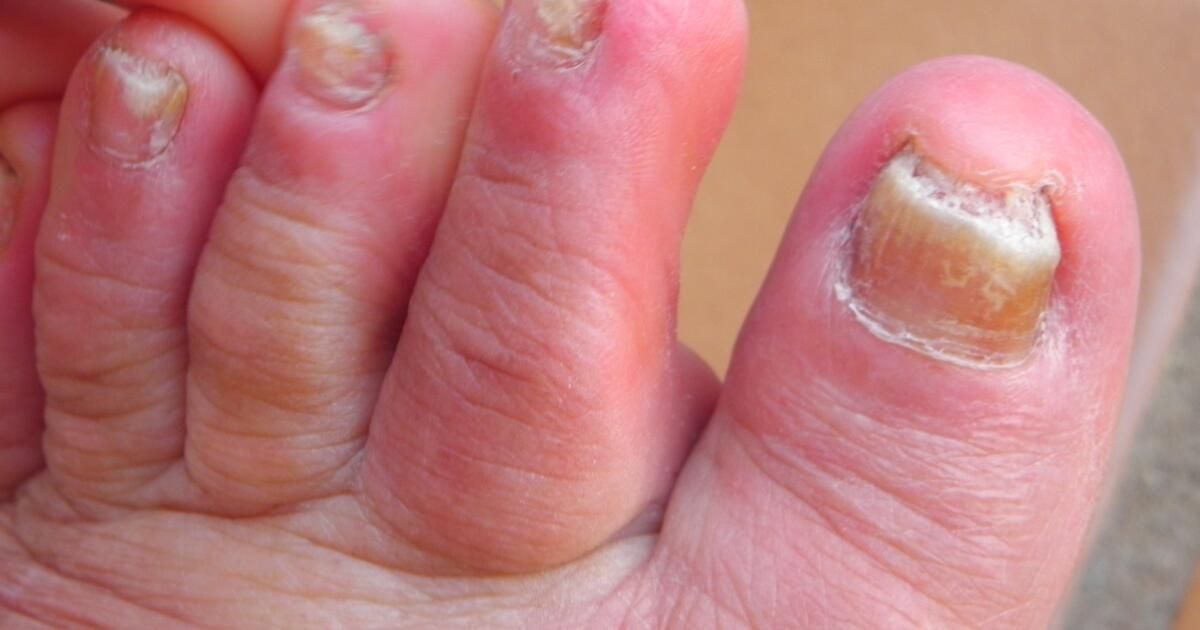

Try One of These 10 Home Remedies for Toenail Fungus
Toenail fungus, also known as onychomycosis or tinea unguium, is a common nail condition affecting millions of people in the United States. Fungal nail infections can develop on the nail from various organisms such as molds, yeasts, and fungi. This usually occurs after these organisms come into contact with a cracked nail or skin surrounding the nail as the opening provides a portal of entry for these organisms.
Risk factors
When your feet sweat or remain moist or damp, the opportunity for the fungus to grow on your toenails increases. Frequent exposure to warm, moist environments such as swimming pools, locker rooms, or even living in a humid climate places you more at risk of developing these types of infections. This is also why these infections seem to be more prevalent during the summer months.
Men have been known to develop these types of infections more than women as well as individuals with weakened immune systems—people with diabetes, poor circulation, and older adults. Individuals who frequent nail salons may also be placing themselves at risk of developing and spreading fungal infections to their feet. Evidence of a toenail infection includes discoloration in nail color which may be white, yellow, brown, or even black. The nail may become thickened, which makes it difficult for you to care for the nail on your own. Foul odor, brittleness, or even complete separation of the nail from the nail bed may occur.
Diagnosis
In order to confirm a toenail fungus, your doctor will first evaluate your feet. They may also decide to perform a culture where samples of the nail or skin may be taken for further evaluation at a laboratory. Because there are other causes of nail changes (psoriasis, microtrauma, poor nutrition, staining from nail polish), this is a vital step in picking the most appropriate treatment.
16 best home remedies for toenail fungus
A variety of treatment options for toenail fungus are available, including drug-free alternatives, over-the-counter medicine, prescription drugs, laser treatment, or even surgical removal for those severe cases. Most people start with items they have around the house before purchasing medication or visiting their doctor’s office. These treatments are most effective in mild fungal cases.
Unfortunately, there are no “quick fixes” when it comes to treating nail fungus. This is because a new toenail must grow to replace the old, damaged toenail. Typically, this takes anywhere from nine to 12 months to regrow the entire big toenail and approximately six months for the lesser toenails. This time frame varies on how fast or slow your toenails grow and how severe the fungal infection is. Many home remedies quickly improve the appearance of the nail, but the actual fungus is not gone until the new, healthy nail has replaced the old, damaged one.
1. Weekly maintenance
First, prepare your nails for treatment by trimming and filing them once a week. Clipping toenails relieves pressure on the nails and helps antifungal solutions penetrate the nail. Use traditional toenail clippers and an Emory board to keep nails short and thin. Make sure to disinfect utensils after each use. Maintaining trimmed, clean, and dry nails will be essential in treating toenail fungus and preventing it in the future.
2. Clean socks and shoes
Regularly changing your socks and shoes can also cut down on the growth of unwanted foot fungus. Both socks and athletic shoes can be washed in hot water to rid the growth of yeasts and fungi that may be growing on the fabric. Adding a half-cup of baking soda or one cup of vinegar to the washing machine can help eliminate bacteria or fungus on socks or shoes. Some shoes can be machine dried. Drying shoes in the sun is another option when cleaning footwear.
Boots and other footwear that are not machine washable could be wiped out with a vinegar and water solution or sprayed with an over-the-counter (OTC) antifungal spray. Medicated powders are also helpful in treating shoes for foot fungus.
Allowing the feet to breathe by taking off shoes and socks when possible can prevent fungal growth. Protect your feet by wearing breathable footwear and clean socks. Antimicrobial socks and shoes made from bamboo, copper, or specialty fabrics are also available. They can help reduce unwanted bacteria and yeast from growing in your footwear.
A proactive approach to keeping your feet clean and dry can prevent the spread of toenail fungus. You can wash or soak feet with warm soapy water or a foot bath using everyday household items. Soaking your feet in an all-natural, homeopathic concoction can be beneficial in reducing or eliminating toenail fungus.
3. Hydrogen peroxide
Hydrogen peroxide can kill fungus that grows on toenails. You can directly wipe hydrogen peroxide on your infected toes or toenails with a clean cloth or cotton swab. Hydrogen peroxide can also be used in a foot soak. Mix 1/8 cup of hydrogen peroxide (or several capfuls) to four cups of cool water and soak feet for 10 to 20 minutes. Rinse feet with warm water and pat dry.
4. Black tea
Soaking feet in plain tea can also be beneficial in treating toenail or foot fungus. Black tea contains tannic acid that dries out the feet, kills bacteria, and helps to close the foot’s pores to reduce sweating. Boil two quarts of water then add five to six tea bags. Allow the tea to cool and soak feet for 30 minutes. Use this foot soak daily if desired.
5. Apple cider vinegar
Another home remedy to treat toenail fungus includes the use of apple cider vinegar. Vinegar is an antifungal ingredient that can be mixed with water to create a foot soak. It’s acetic acid component helps to whiten discolored toenails and stop the spread of the infection to other toes. Try two parts vinegar to one part warm water and soak feet for 20 minutes daily. For a more potent foot soak, the ratio could be one part vinegar to one part water. If the smell is too overwhelming, essential oils can be added to make the experience more pleasant. White vinegar can be used as an alternative as both are equally effective.
6. Baking soda
Add baking soda to a foot soak to heal the affected nail. You can also make a paste of baking soda with a minimal amount of water and apply it directly to the foot. Allow the paste to sit on the affected area for 10 to 20 minutes, then rinse with warm water and dry the foot thoroughly.
Baking soda can also be sprinkled onto the foot or in the shoes like foot powder. Once applied to a dry foot, put on clean socks; the baking soda can wick away moisture while healing properties work to reduce toenail fungus.
7. Epsom salt
Soaking feet in an Epsom salt (magnesium sulfate) bath can be beneficial to relieve your foot fungus. You can mix one cup of Epsom salt to two quarts of warm to hot water and soak your feet for 10 to 20 minutes. You could also try a more elaborate Epsom salt concoction that includes:
- 4 cups warm to hot water
- 1/2 cup Epsom salt
- 1/2 cup baking soda
- 1/4 cup hydrogen peroxide
- 1/4 cup vinegar
Mix all of the ingredients and soak feet for 15 to 20 minutes. Essential oils are a great addition to foot baths. Essential oils with healing properties to treat foot fungus are listed below. Following your foot soak, rinse your feet with clean water and pat dry with a clean towel. To avoid contaminating clean feet, put on clean socks and breathable shoes following your foot bath.
8. Essential oils
Essential oils are gaining popularity in homeopathic treatment to heal a variety of common ailments. Many essential oils have natural antibacterial and antifungal properties. Some essential oils that could help reduce toenail fungus include:
- Tea tree oil
- Clove oil
- Clary sage oil
- Jasmine oil
- Lavender oil
- Ylang-ylang oil
- Eucalyptus oil
- Cinnamon oil
- Lemon oil
- Lemongrass oil
- Thieves oil
- Wild oregano oil
- Jojoba oil
- Manuka tree oil
Dilute essential oils with a carrier oil, such as coconut oil or olive oil, before applying them to the skin. Mix the desired oil or combination of oils with a carrier oil of your choice and apply a few drops to the affected nail. As previously mentioned, you can also add two to three drops of essential oils to footbaths.
9. Ozonated oils
Ozonated oils, such as olive and sunflower oil, contain ozone gas. The idea is that ozone delivers oxygen to the affected areas, which kills bacteria and stimulates skin cells for faster healing. One study found that ozonated oil is an effective home remedy for toenail fungus. Researchers tested ozonized sunflower oil on 101 samples of yeast. The oil was an effective treatment against several fungal strains. To try this remedy, clean and dry your foot first. Gently massage a small amount of ozonated oil into the skin, working it into the affected nails and around the entire toe.
10. Olive leaf extract
Olive leaf extract contains oleuropein, which is a natural antifungal and antimicrobial. A salve made from the olive leaf can be applied to the toenails to reduce infection. You may also swallow capsules containing the extract to boost the immune system and treat toenail fungus systemically. Approximately two olive leaf extract capsules can be taken twice a day for an extended period. Consult your healthcare provider before taking olive leaf extract.
11. Snakeroot extract
Snakeroot extract, made from plants in the sunflower family, is an all-natural antifungal homeopathic treatment also used to treat toenail fungus. Commonly used in Ayurvedic practices in India, snakeroot extract can be applied directly to the affected toenail. Apply the extract two to three times a week for several months. Ask your healthcare provider if snakeroot extract is right for your type of foot fungus.
12. Zinc
Zinc oxide is a mineral that can treat fungal infections. As a skin protectant, miconazole-zinc oxide can be sprayed or applied to the affected area to fight infection and reduce signs of foot fungus. Check with your provider to see if adding zinc to your foot care regimen is right for you.
13. Garlic
Garlic is a potent antimicrobial plant. For topical treatment, chop cloves of garlic and leave it on the affected nails for 30 minutes. Use raw garlic sparingly, as it can result in a chemical burn.
Ask a pharmacist about herbal supplements that contain garlic. These supplements can be taken orally to not only treat skin infections but also high blood pressure, heart disease, certain cancers, and prevent tick bites. Garlic supplements should not be taken by people with stomach ulcers, digestion problems, or bleeding disorders. It might also make birth control pills less effective. Talk to a healthcare professional before taking oral garlic supplements.
14. Cornmeal
Cornmeal has some antifungal properties. You can try applying cornmeal as a paste or a soak. For a paste, dissolve cornmeal in warm water in a shallow pan. Let the paste cool before using it on your feet. Let it sit for an hour. As a soak, add an inch of cornmeal to a shallow container. Pour an inch of warm water on top of the cornmeal, letting the cornmeal and water mix naturally for an hour. Then, add enough warm water to cover your entire foot and let it soak for an hour. You can try cornmeal as a weekly home remedy for toenail fungus.
15. Diet
Your current diet could be feeding fungus caused by Candida overgrowth. Here are some diet changes you can make to starve the yeast and improve toenail fungus:
- Cut out sugar
- Don’t drink alcohol
- Limit your carbohydrates to one cup a day
- Cook with coconut oil
- Incorporate ginger and garlic
- Supplement with a probiotic
16. Exercise
Regular exercise can expedite the healing process. As blood pumps faster through the body, it releases natural vitamins and flushes toxins. Just be sure to practice proper hygiene to avoid making toenail fungus worse. Wear socks that wick away excess moisture, use antifungal foot powder, remove shoes immediately after a workout to let feet breathe, and wear flip-flops or sandals in shower rooms or pools. Remember to wash your feet with antibacterial soap and completely dry your feet after your shower.
Unsafe home remedies for toenail fungus
Although there are many effective home remedies for toenail fungus, there are still some natural and household products that can cause more harm than good. For example, you should never use bleach to get rid of toenail fungus. Its use may be toxic to the skin and cause severe skin irritation when not used properly.
Additionally, you should never use overly hot water when performing the variety of foot soaks mentioned above. Excessive heat to the nails and skin will not kill fungus—and extreme temperatures may injure the skin causing burns, blisters, and sometimes permanent skin damage. Always use lukewarm water for soaking.
Urine is another home remedy that should be avoided. Previously, it had been believed to be effective against fungal infections due to its urea contents. While urea is needed for the management of nail fungus, urine does not have high enough concentrations to be effective.
And, finally, do not remove or excessively trim toenails at home. Fungal toenails should be properly trimmed and maintained on a regular basis, but do not remove too much nail. If toenail clipping or removal is not done properly, damage to the nail bed may cause additional injury to the nail, which can be irreversible. There also is the risk of causing bacterial infections when the damaged nail is not removed properly.
If the natural remedies for toenail fungus listed above do not work, there are other effective treatments for toenail fungus available at the drugstore.
Over-the-counter toenail fungus treatment options
While home treatments can be the cure you are looking for to treat toenail fungus, they’re not regulated or approved by the Food and Drug Administration (FDA). Over-the-counter antifungal creams, lotions, sprays, and even medicated nail polish are available. Home remedies can often enhance the efficacy of these products.
Vicks VapoRub
One of the more popular over-the-counter remedies for treating toenail fungus is using Vicks VapoRub. Mentholated salves contain the natural ingredients menthol, eucalyptus oil, and camphor. Use Vicks alone or in conjunction with other treatments and medications. Clean feet and apply a small amount of Vicks VapoRub daily.
Listerine
Soaking an infected nail in the OTC product Listerine can also help reduce or kill toenail fungus. Commonly used as a mouthwash, Listerine applied to the affected toe or toenail for 20 minutes twice a day can effectively reduce signs of onychomycosis.
Athlete’s foot medication
Athlete’s foot sprays, powders, and creams are helpful in stopping fungal growth before it develops on the toenail or surrounding flesh. Brand-name products that you can purchase without a prescription include Tinactin (tolnaftate), Micatin (miconazole), Lamisil (terbinafine), and Lotrimin AF (clotrimazole). Ask a pharmacist at your local drugstore which is the best medication for your symptoms.
RELATED: Athlete’s foot treatments and medications
Toenail fungus prescription medications
Sometimes prescription medications are needed to treat a toenail infection that just won’t go away with natural remedies or over-the-counter medication in a few months. In this case, prescription-strength antifungal medication can eradicate stubborn onychomycosis.
Topical antifungal medications often are effective in treating mild to moderate toenail fungus. Topical solutions may include medicated nail polishes or liquid medications. Loprox (ciclopirox), Penlac (ciclopirox), Kerydin (tavaborole), and Jublia (efinaconazole) are among the top prescription drugs for toenail fungus. Some topical treatments require you to file down the surface of the nail to help the treatment get through to the nail bed.
Oral antifungal medications can come in capsules, tablets, or liquid. Some common prescriptions are Diflucan (fluconazole), Lamisil (terbinafine), Onmel (itraconazole), and Sporanox (itraconazole).
Side effects of toenail fungus medication
One of the many benefits of using a homeopathic remedy is that there are little to no adverse side effects. Topical treatments often prescribed to treat toenail fungus can potentially burn or blister the skin. Oral medications for treating onychomycosis can cause liver or gastrointestinal damage. Be sure to read your medication’s list of potential side effects. Consult your pharmacist, healthcare provider, or specialist if you are concerned about side effects of prescription drugs.
When to see a doctor about toenail fungus
If you are experiencing persistent toenail fungus or pain is present, you may need to see a specialist. A dermatologist or podiatrist may be able to assess your symptoms and send a small sample of the affected toenail or flesh to a laboratory to be analyzed as there are various types of fungi and yeasts that cause onychomycosis. Knowing the specific cause of your foot fungus can help identify what route to take to treat your condition.
Nail changes can also be caused by underlying conditions, like psoriasis and diabetes, so it’s important to seek professional medical advice if your condition persists or worsens. Bacterial and fungal infection of skin in diabetes patients often result in hospital admissions, and in severe cases, can result in amputations. If you are at a higher risk for infection, you should skip home remedies and seek professional medical treatment.
Recommended Videos
 Valentine’s Day Roses48 views
Valentine’s Day Roses48 views 49 Super DIY low budget ideas for decorating your yard and garden1702 views
49 Super DIY low budget ideas for decorating your yard and garden1702 views-
Advertisements
 28 Species Of Birds Named By People Who Clearly Hate Birds752 views
28 Species Of Birds Named By People Who Clearly Hate Birds752 views Orchid mantis (Hymenopus coronatus)567 views
Orchid mantis (Hymenopus coronatus)567 views Unique Orange and Black ‘Fox’ Poses for Friendly Photographer153 views
Unique Orange and Black ‘Fox’ Poses for Friendly Photographer153 views Hidden Camera Catches Doting Eagle Doing Everything He Can To Please His Wife87 views
Hidden Camera Catches Doting Eagle Doing Everything He Can To Please His Wife87 views The Corpse Flower: Description, Life Cycle, Facts, and More258 views
The Corpse Flower: Description, Life Cycle, Facts, and More258 views 10 Captivating Aerial Photographs Of Ballet Dancers Captured By Brad Walls364 views
10 Captivating Aerial Photographs Of Ballet Dancers Captured By Brad Walls364 views



